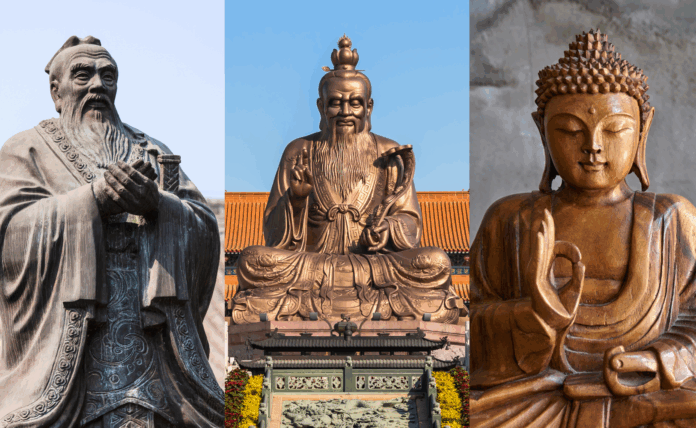
Although humanity has entered the 21st century, wars and conflicts continue to smolder in various regions. Behind many hotspots lie religious entanglements that have endured for millennia. Every explosion echoes an old question: why does peace remain elusive?
Across world history, religion has frequently served as a catalyst for conflict. At the end of the 11th century, Crusader armies marched eastward and drenched Jerusalem in blood. In the 13th century, the papacy launched ferocious inquisitions that reduced countless so-called heretics to ashes. The 16th-century French Wars of Religion led to rivers of Protestant blood flowing down the Seine. Even today, in the Balkans, the Persian Gulf, and the Indian subcontinent, religious divides remain embedded in many confrontations.
Yet when the lens of history shifts eastward to China, a markedly different picture emerges. Although the Yellow Turban uprising invoked apocalyptic prophecy and the Taiping Heavenly Kingdom bore the banner of the God Worshipping Society, the underlying drivers of these upheavals were not religious doctrine but land concentration, socioeconomic inequality, and systemic oppression. Faith served as an idiom, not a cause.
The contrast begins with fundamentally different social and political structures. Early Chinese society, like many ancient civilizations, revered natural phenomena as divine forces and practiced harsh sacrificial rites. However, as shamanistic authority grew dangerously unrestrained—when anyone could claim to speak for the gods—Chinese rulers undertook a civilizational reform that altered the trajectory of political development. Ancient texts record the deliberate “severing of the connection between Heaven and humanity,” a governance innovation that centralized the right to interpret divine will. Communication with Heaven became the exclusive prerogative of the ruler and state-sanctioned ritual experts, curbing religious privatization and preventing charismatic individuals from mobilizing divine authority for rebellion.
This early institutional arrangement, consolidated in the Zhou dynasty’s rites-and-music system, gradually transformed Chinese society into one governed by secular ethics rather than priestly theocracy. While other civilizations still relied on sacrificial violence to secure divine favor, the Zhou political order placed social hierarchy, ritual propriety, and moral governance at its core. The ruler derived legitimacy not from divine command alone but from the ethical requirement to “match Heaven’s virtue.” Divine will become a moral criterion rather than an instrument of domination.
This shift marked a profound divergence from the West. Western intellectual history evolved under the towering influence of theology; Chinese thought moved toward ethical humanism. Confucius’s famous admonition—If one cannot yet serve humans, how can one serve spirits?—encapsulates this transformation. Religious life persisted, but its authority was subordinated to moral cultivation, social relations, and political order. Over time, this human-centered orientation solidified into a stable civilizational pattern: rulers upheld Confucianism as the ideological orthodoxy, while diverse beliefs—Buddhism, Daoism, folk religions, and foreign faiths—were allowed to coexist within a secular state framework.
This orientation was reinforced by China’s social structure. Genealogical networks and ancestral halls created deeply rooted kinship order long before temples and churches emerged. In the Mediterranean world, the mobility of traders and the fragmentation of communities gave religions a unique bridging function; in China, lineage-based order endowed society with cohesiveness, reducing the need for religious authority to manage social bonds.
Religion in China was also shaped by the distinctive conception of “Heaven.” Unlike monotheistic traditions centered on a single, exclusive deity, Chinese culture envisioned an abstract, transcendent, and impersonal Heaven—omnipresent yet formless, moral rather than dogmatic. Numerous deities existed in popular worship, but none eclipsed Heaven as the supreme moral order. This nonexclusive, nonanthropomorphic Heaven served as a universal reference point that could accommodate multiple faith traditions without generating doctrinal conflict.
This worldview intertwined naturally with ancestral reverence, extending ethical relationships outward from family to society. Concepts such as ruler and subject, father and son, teacher and student, and sworn brothers functioned as quasi-kinship ties, binding unrelated individuals within a shared moral framework. Philosophers such as Cheng Hao and Wang Yangming later expanded this ethic of kinship into cosmological humanism, proposing the unity of humanity with nature and all beings. In such a worldview, religious difference rarely escalated into existential confrontation, because ethical integration overrides metaphysical exclusivity.
Thus, when Buddhism, Islam, and later Christianity entered China, they encountered a civilizational logic predisposed toward accommodation rather than confrontation. Foreign religions were transformed—Sinicized—in ways that allowed them to coexist with Confucian norms, and in turn contributed new philosophical elements to Chinese thought. The result was an evolving ecosystem of beliefs rather than a battlefield of competing dogmas.
At the civilizational level, this inclusiveness was reinforced by the Chinese conception of “all under heaven” (tianxia), a political and cultural imagination that transcended geography. Unlike the Western concept of the “world” as a collection of rival polities, the Chinese tianxia referred to a moral and cultural sphere unified by shared norms—something larger than territory but more cohesive than mere geography. It formed the ideological foundation for repeated historical unifications across a landmass comparable to Europe, where no analogous unifying concept existed.
When dynasties collapsed or foreign powers conquered the Central Plains, tianxia consciousness enabled re-integration. Ethnic differences, religious diversity, and regional particularities were subsumed into a broader civilizational identity. Buddhist bells, Daoist rituals, Confucian ceremonies, steppe traditions, and frontier customs coexisted within a common cultural framework that emphasized harmony over domination.
Over thousands of years, this cultural logic prevented large-scale religious wars in China and discouraged missionary conquest or cultural extermination. Instead, Chinese civilization absorbed and transformed external influences, generating a historically rare model of cultural continuity without theocratic conflict or colonial expansion.
The wisdom embedded in this tradition carries contemporary relevance. In an era of geopolitical tension and global fragmentation, the Chinese ethos of harmony, inclusiveness, and cultural symbiosis offers an alternative to zero-sum confrontation. As modern Chinese leaders emphasize, the ideals of “all under heaven as one family” and “harmony among all nations” derive from deep historical roots and reflect a worldview committed to coexistence rather than domination.
A genuine global perspective does not demand uniformity or erasure; it requires the capacity for different civilizations, ethnicities, and faiths to share the same sky peacefully. The inclusive and humanistic foundations of Chinese civilization, formed over millennia, continue to offer valuable insight for building a shared future for humanity.
Source: neac gov, scmp, sohu, zhihu, cuhk



